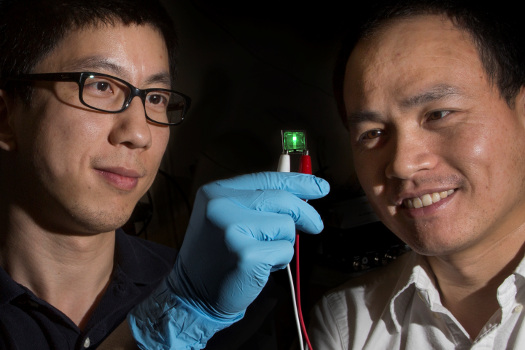 |
| November 24, 2015 | Volume 11 Issue 44 |
Designfax weekly eMagazine
Archives
Partners
Manufacturing Center
Product Spotlight
Modern Applications News
Metalworking Ideas For
Today's Job Shops
Tooling and Production
Strategies for large
metalworking plants
Researchers create cheaper, high-performing LED

Assistant Professor of Physics Hanwei Gao and Associate Professor of Chemical Engineering Biwu Ma examine their new LED material. [Bruce Palmer/Florida State University]
A team of Florida State University materials researchers has developed a new type of light-emitting diode, or LED, using an organic-inorganic hybrid that could lead to cheaper, brighter, and mass-produced lights and displays in the future.
Assistant Professor of Physics Hanwei Gao and Associate Professor of Chemical Engineering Biwu Ma are using a class of materials called organometal halide perovskites to build a highly functioning LED. They lay out their findings in the journal Advanced Materials.
"Early work suggested perovskites could be a promising material to build LEDs," Gao said. "But the performance was not up to their potential. We believed there was significant room for improvement."
Perovskites are any materials with the same type of crystal structure as calcium titanium oxide. Other researchers experimented with perovskites to build LEDs in the past but could not build particularly effective ones. Gao and Ma believed this organic-inorganic hybrid could perform better, if the formula could be appropriately tweaked.
"When we thought about this class of material, we knew it should perform better than this," Ma said. "We came up with our novel approach to solve some critical problems and get a high-performance LED."
After months of experiments using synthetic chemistry to fine-tune the material properties and device engineering to control the device architectures, they ultimately created an LED that performed even better than expected.
The material glowed exceptionally bright.
It is measured at about 10,000 candelas per square meter at a driving voltage of 12V -- candelas are the unit of measurement for luminescence. As a benchmark, LEDs glowing at about 400 candelas per square meter are sufficiently bright for computer screens.
"Such exceptional brightness is, to a large extent, owing to the inherent high luminescent efficiency of this surface-treated, highly crystalline nanomaterial," Gao said.
It was also quick and easy to produce.
Gao and Ma can produce the material in about an hour in the lab and have a full device created and tested in about half a day.
Additionally, while bare hybrid perovskites tend to be unstable in humid air, the nanostructured perovskites exhibit remarkable stability in ambient environment because of the purposely designed surface chemistry. Such chemical stability largely reduces the requirement of sophisticated infrastructure to produce this new type of LEDs and could be of huge benefit for cost-effective manufacturing in the future.
The research is crucial to the advance of LED technology, which is fast becoming an avenue to reduce the country's electric consumption. LED lighting is already sold in stores, but widespread adoption has been slow because of the costs associated with the material and the quality.
But LED lights do save energy.
According to the U.S. Department of Energy, residential LED lighting uses at least 75 percent less energy than regular incandescent lighting.
"If you can get a low-cost, high-performing LED, everyone will go for it," Ma said. "For industry, our approach has a big advantage, in that earth-abundant materials can be processed in an economic way to make the products."
Source: Florida State University
Published November 2015
Rate this article
View our terms of use and privacy policy
